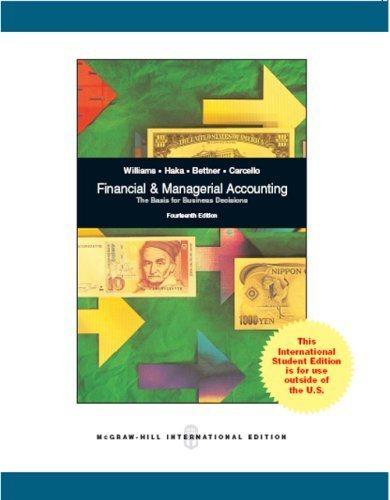Question
In most cases, accountants usegenerally accepted accounting principles (GAAP)when preparing financial statements in the U.S. GAAP is a set of standards and principles designed to
In most cases, accountants usegenerally accepted accounting principles (GAAP)when preparing financial statements in the U.S. GAAP is a set of standards and principles designed to improve the comparability and consistency of financial reporting across industries. Its standards are based on double-entry accounting, a method in which every accounting transaction is entered as both a debit and credit in two separate general ledger accounts that will roll up into the balance sheet and income statement.
Example of Accounting
To illustrate double-entry accounting, imagine a business sends an invoice to one of its clients. An accountant using the double-entry method records a debit to accounts receivables, which flows through to the balance sheet, and a credit to sales revenue, which flows through to the income statement.
When the client pays the invoice, the accountant credits accounts receivables and debits cash. Double-entry accounting is also called balancing the books, as all of the accounting entries are balanced against each other. If the entries aren't balanced, the accountant knows there must be a mistake somewhere in thegeneral ledger.In most cases, accountants usegenerally accepted accounting principles (GAAP)when preparing financial statements in the U.S. GAAP is a set of standards and principles designed to improve the comparability and consistency of financial reporting across industries. Its standards are based on double-entry accounting, a method in which every accounting transaction is entered as both a debit and credit in two separate general ledger accounts that will roll up into the balance sheet and income statement.
Example of Accounting
To illustrate double-entry accounting, imagine a business sends an invoice to one of its clients. An accountant using the double-entry method records a debit to accounts receivables, which flows through to the balance sheet, and a credit to sales revenue, which flows through to the income statement.
When the client pays the invoice, the accountant credits accounts receivables and debits cash. Double-entry accounting is also called balancing the books, as all of the accounting entries are balanced against each other. If the entries aren't balanced, the accountant knows there must be a mistake somewhere in thegeneral ledger.In most cases, accountants usegenerally accepted accounting principles (GAAP)when preparing financial statements in the U.S. GAAP is a set of standards and principles designed to improve the comparability and consistency of financial reporting across industries. Its standards are based on double-entry accounting, a method in which every accounting transaction is entered as both a debit and credit in two separate general ledger accounts that will roll up into the balance sheet and income statement.
Example of Accounting
To illustrate double-entry accounting, imagine a business sends an invoice to one of its clients. An accountant using the double-entry method records a debit to accounts receivables, which flows through to the balance sheet, and a credit to sales revenue, which flows through to the income statement.
When the client pays the invoice, the accountant credits accounts receivables and debits cash. Double-entry accounting is also called balancing the books, as all of the accounting entries are balanced against each other. If the entries aren't balanced, the accountant knows there must be a mistake somewhere in thegeneral ledger.
Question 4
1. State a concern's billed cycle______?
2. Define a company's payable_________ cycle?
3. Could you repeat that_________ quantity of reckoning acquaintance is vital or _________obligatory in accounting?
4. Outline fliers______ receivable? Very generally asked cost accountant meeting questions_______?
5. Define depreciation __________and its types?
6. Segregate among consignor and consignee_______?
7. What are the pre-requisites of revenue recognition________?
8. How chief is______ credentials when it comes to accountancy_______?
9. _________Pardon are Accounting Values__________?
10. Pardon is _______a IMMOVABLE ASSET register______?
Step by Step Solution
There are 3 Steps involved in it
Step: 1

Get Instant Access to Expert-Tailored Solutions
See step-by-step solutions with expert insights and AI powered tools for academic success
Step: 2

Step: 3

Ace Your Homework with AI
Get the answers you need in no time with our AI-driven, step-by-step assistance
Get Started


